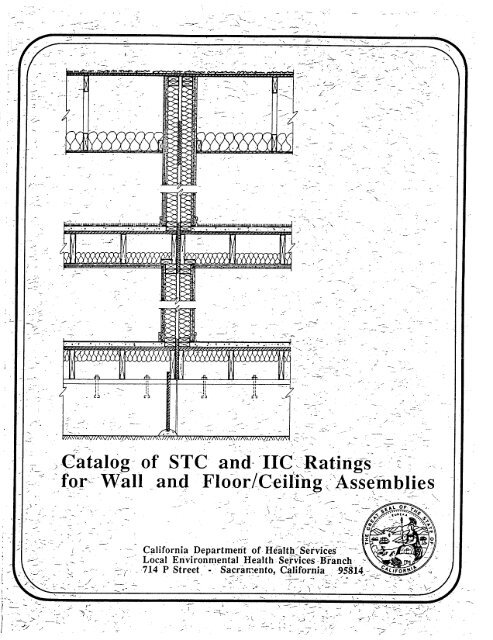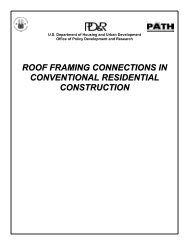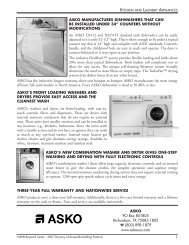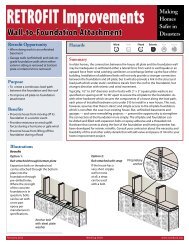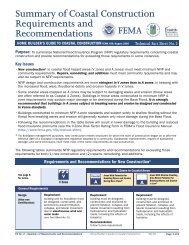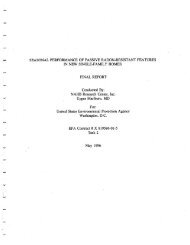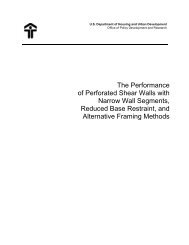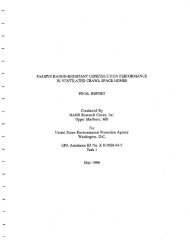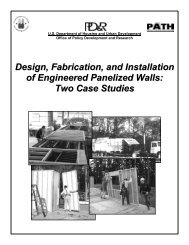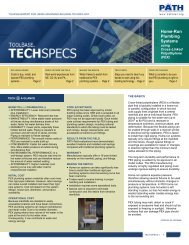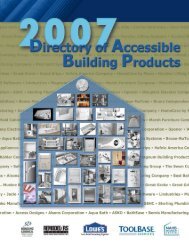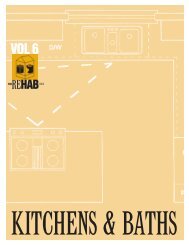Catalog Of STC And IIC Ratings For Wall - ToolBase Services
Catalog Of STC And IIC Ratings For Wall - ToolBase Services
Catalog Of STC And IIC Ratings For Wall - ToolBase Services
You also want an ePaper? Increase the reach of your titles
YUMPU automatically turns print PDFs into web optimized ePapers that Google loves.
<strong>Catalog</strong> of <strong>STC</strong> and <strong>IIC</strong> <strong>Ratings</strong> for<br />
<strong>Wall</strong> and Floor/Ceiling Assemblies<br />
Russell B. DuPree<br />
<strong>Of</strong>fice of Noise Control, California Department of Health <strong>Services</strong><br />
Berkeley, California 94704<br />
Introduction building codes.<br />
This catalog of sound-rated wall and The purpose of the indexing system is<br />
floor/ceiling assemblies was compiled from to enable the user to quickly find a group of<br />
laboratory test reports submitted to the Cali- construction assemblies having similar<br />
fornia <strong>Of</strong>fice of Noise Control by various sound transmission characteristics. Most<br />
manufacturers, trade associations and section headings were selected to group the<br />
government agencies. It contains <strong>STC</strong> assemblies according to the following<br />
(Sound Transmission Class) or <strong>IIC</strong> (Impact<br />
Insulation Class) ratings for approximately<br />
500 different construction assemblies. Each<br />
assembly has been assigned a unique reference<br />
number through an index system. Test<br />
summaries were reviewed by the submitting<br />
acoustically important properties:<br />
mass<br />
structural continuity<br />
depth of air cavity<br />
cavity absorption<br />
organizations and are produced here with There are five section heading levels in the<br />
their permission. index. Each section level is indented from<br />
The catalog is intended to aid California<br />
Building <strong>Of</strong>ficials in determining complithe<br />
preceding level and printed in a smaller<br />
type size. The number in parenthesis after<br />
ance with the state's noise insulation stan- fifth level section headings is the number of<br />
dard for multifamily housing (Section 1092 tests in that section. Many fifth level secof<br />
Title 25 of the California Administrative tion headings show no tests at all, neverthe-<br />
Code). It may be used to evaluate a given<br />
construction assembly or to compare assemless<br />
they are listed in the index in order to<br />
maintain continuity and to allow for addiblies<br />
of different types. Although the catalog<br />
contains data on many commonly used<br />
wall and floor/ceiling designs, other laboratory<br />
tests may be considered in evaluating<br />
an assembly for compliance with the stantions<br />
to the. catalog at a future date. A<br />
given party wall or floor/ceiling assembly<br />
may be located in the 'catalog by selecting<br />
the appropriate headings from the index,<br />
starting with the first level and continuing<br />
dard. Architects, builders and other design through the fifth level.<br />
professionals may also find the catalog use- The following example illustrates how<br />
ful in selecting assemblies which provide to locate a given wall type in the index:<br />
good noise insulation. Assume that the architect's drawings show a<br />
party wall similar to the one below. It is<br />
How to use the catalog made up of 2x4 studs spaced 16" o.c. and<br />
The catalog is divided into sections and<br />
subsections which indicate major differences<br />
in acoustic performance and construction<br />
staggered 8" o.c. on 2x6 plates. The wall<br />
faces are 1/2" gypsum board and the cavity<br />
is filled with a 3 1/2" thick porous insulating<br />
type. Section headings are listed in the materia1.<br />
index along with the level and number of<br />
the sections. A hierarchy of section levels is<br />
produced by a series of numbers, each followed<br />
by a period. <strong>For</strong> example, second<br />
level section headings are indicated by two<br />
numbers followed by periods; third level<br />
section headings by three numbers followed In the index there is a group of wall<br />
by periods, and so forth. Similar techniques<br />
for section hierarchy are used in most basic<br />
assemblies similar to the one described<br />
above. To find that group, first look at all
section headings which contain only one<br />
number. There are two of them - " 1.<br />
Now the search for a comparable test<br />
report has been narrowed to a few assem-<br />
<strong>Wall</strong> assemblies “ and “ 2. Floor assem- blies which are listed in section 1.2.3.1.4.<br />
blies “. This example is obviously a wall<br />
assembly, so all sections which begin with<br />
To find this section in the catalog, simply<br />
look at the right hand column under "Secthe<br />
number “ 2. “ can be disregarded. tion Number" and follow the sequence of<br />
The next step is to look for the<br />
appropriate second level section heading.<br />
From the index, the choices are:<br />
1.1. Studless walls<br />
1.2. Wood stud walls<br />
1.3. Metal stud walls<br />
1.4. Masonry walls<br />
numbers until you come to 1.2.3.1.4. (on<br />
page 50). You will notice that there are<br />
eleven tests listed and that the fourth test in<br />
the group (1.2.3.1.4.4) matches the description<br />
in the example.<br />
Each assembly in the catalog is drawn<br />
to a scale of one inch = one foot and<br />
presented beside a summary description of<br />
The correct choice here would be “ 1.2. the assembly components. Other informa-<br />
Wood stud walls “. tion given on each assembly includes the<br />
Under the section heading “ 1.2. “,<br />
the choices for third level section headings<br />
are:<br />
1.2.1. Single wood studs,<br />
no decoupling connectors<br />
name of the laboratory which tested the<br />
assembly, the test number designated by the<br />
laboratory, the year, the number of frequencies<br />
tested (either 11 or 16) and the name<br />
of the organization which supplied the data<br />
for this catalog. The <strong>STC</strong> and <strong>IIC</strong> ratings<br />
1.2.2. Single wood studs,<br />
with decoupling connectors<br />
1.2.3. Staggered wood studs on single plates<br />
1.2.4. Double wood studs on separate Plates<br />
are shown in bold face type in another<br />
column. The column with the three dots is<br />
for information which may be added at a<br />
future date. Occasionally information was<br />
Here the correct choice is “ 1.2.3. Staggered<br />
wood studs on single plates “.<br />
not available and is so indicated by the<br />
letters "NA".<br />
Now the choices for fourth level section<br />
headings are:<br />
1.2.3.1. One leaf each face<br />
1.2.3.2. Two leaves each face<br />
1.2.3.3. Three leaves each face<br />
1.2.3.4. More than three leaves each face<br />
Laboratory and field tests<br />
The single number ratings <strong>STC</strong> and<br />
<strong>IIC</strong> are determined in a special laboratory<br />
setting. This setting is designed so that all<br />
sound from the source room is transmitted<br />
to the receiving room only through the test<br />
1.2.3.5. Unbalanced assembly. The sound pressure levels in the<br />
(dissimilar number of leaves each face) source and receiving rooms are averaged<br />
1.2.3.6. Plaster faced over time and space in 16 different fre-<br />
<strong>And</strong> the correct choice here is “ 1.2.3.1.<br />
quency bands, Then the measured levels,<br />
One leaf each face “.<br />
or differences in levels, are evaluated by<br />
<strong>For</strong> the fifth and final section heading<br />
level, choose among the following:<br />
rules which yield a single number rating<br />
called the Sound Transmission Class or the<br />
Impact Insulation Class. This rating can be<br />
1.2.3.1.1. Leaf thickness < 1/4"<br />
1.2.3.1.2. Leaf thickness 1/4"<br />
1.2.3.1.3. Leaf thickness 3/8"<br />
1.2.3.1.4. Leaf thickness 1/2"<br />
compared with the results of other laboratory<br />
tests which use the same rating procedure.<br />
It is important to understand that<br />
the laboratory procedure is designed to<br />
1.2.3.1.5. Leaf thickness 5/8"<br />
measure only the sound transmitted by the<br />
1.2.3.1.6. Leaf thickness 314"<br />
1.2.3.1.7. Leaf thickness >= 1"<br />
test assembly.<br />
In the field, however, tests are usually<br />
Since the face leaves of this example are<br />
1/2" thick, the correct choice is “ 1.2.3.1.4.<br />
Leaf thickness 1/2".<br />
made to determine the amount of sound<br />
transmitted from one room to another<br />
regardless of the sound path. In a properly<br />
constructed building, most of the sound
energy will be transmitted by the separating becomes something of a "magic number". It<br />
assembly itself, but there are many oppor- is not quite reasonable to reject one<br />
tunities for "flanking paths" or "sound leaks" company's test showing an <strong>STC</strong> of 49 and<br />
to occur. Some of the common airborne approve another's of a similar design which<br />
sound transmission flanking paths in build- shows an <strong>STC</strong> of 50. Nevertheless, <strong>STC</strong> 50<br />
ings are: is the minimum rating by state law. When<br />
plenums and suspended ceilings<br />
unbaffled ducts<br />
window to window (outdoors)<br />
common heating units<br />
transoms and air grilles<br />
unblocked joist spaces<br />
uncaulked wall perimeters<br />
ducts, piping and fixtures<br />
masonry joints<br />
discrepancies appear among laboratory <strong>STC</strong><br />
ratings for essentially similar assemblies, and<br />
when the discrepancies are above and below<br />
<strong>STC</strong> 50, field testing may be required to<br />
assure that the building complies with the<br />
standard.<br />
Field tests are useful in determining<br />
the amount of noise isolation between dwel-<br />
ling units in a particular project but they<br />
should not be used for certifying the general<br />
Since a great deal of acoustic energy is approval of a wall or floor/ceiling design.<br />
transmitted through small air gaps or rigid The Building <strong>Of</strong>ficial should rely on labora-<br />
connectors, party walls and floor/ceilings tory tests during the plan review phase<br />
must be carefully designed and built. It is unless the project sponsor agrees to a field<br />
not enough that the architect select a good test of the completed building. The funds<br />
sound insulating assembly; he must also for field testing must then be in escrow<br />
specify properly all connections, seals, pene- before the building permit is issued.<br />
trations and adjacent framing of the assem-<br />
Flanking paths and sound leaks do not<br />
bly.<br />
influence laboratory tests, therefore these<br />
Significance<br />
tests will not necessarily indicate the amount<br />
of laboratory tests<br />
of noise isolation actually achieved in a<br />
Laboratory tests are made under care- completed building. Yet it is the isolation<br />
fully controlled conditions. There will, how- that the occupant is concerned with, not the<br />
ever, be differences in test results among insulation rating (<strong>STC</strong>) of the assembly.<br />
laboratories for assemblies which are of Field tests are, therefore, quite important in<br />
similar design and materials. Even a labora- assuring that the minimum amount of<br />
tory Performing a series of tests on one acoustic privacy is achieved. Field tests may<br />
assembly will not get Precisely the same not be needed on every project, but the<br />
results for each test. There are many rea- Building <strong>Of</strong>ficial should require a field test<br />
sons for this. Some of them relate to the whenever he notes that the structure has<br />
physical configuration of the laboratories and been compromised by flanking paths,<br />
the techniques for measuring sound pressure<br />
level. Others relate to subtle differences in<br />
materials and details of construction. It is<br />
not uncommon to find differences of one or<br />
two <strong>STC</strong> points for similarly designed<br />
assemblies due to the differences between<br />
laboratories and test specimens. Occasionally,<br />
however, there will be large differences<br />
(5 or 6 points) in laboratory <strong>STC</strong> ratings for<br />
essentially similar assemblies. This is usually<br />
because there is a pronounced dip in the<br />
test curve and the <strong>STC</strong> rating is heavily<br />
influenced by a measurement in one frequency<br />
band.<br />
The standard requires a minimum<br />
laboratory <strong>STC</strong> rating of 50 for party walls<br />
and floor/ceilings. All too often this


